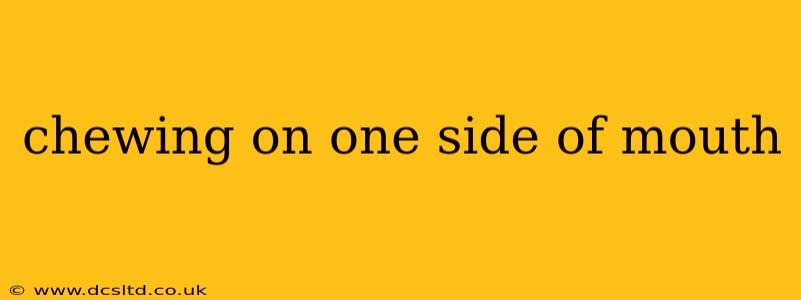Chewing predominantly on one side of your mouth is a common habit many people experience without realizing it. While it might seem like a minor quirk, consistently chewing on one side can lead to several oral health issues down the line. This comprehensive guide delves into the potential causes, associated concerns, and effective solutions to help you understand and address this habit.
Why Do I Chew on One Side of My Mouth?
This seemingly simple question can have a variety of answers. The reasons are often multifaceted and interconnected, ranging from simple preference to underlying medical conditions.
Habit and Preference:
Many people simply develop a preference for chewing on one side, often without conscious awareness. This can start in childhood and continue into adulthood. It's a habit formed over time, much like other ingrained behaviors.
Teeth Grinding (Bruxism):
If you grind your teeth, especially at night (sleep bruxism), you might unconsciously avoid chewing on the side with worn-down or sensitive teeth. This protective mechanism shields the affected area from further discomfort.
Temporomandibular Joint (TMJ) Disorders:
TMJ disorders affect the jaw joint and surrounding muscles. Pain or discomfort in the jaw joint can make chewing on one side more comfortable, leading to a compensatory chewing pattern.
Dental Issues:
Existing dental problems such as cavities, fillings, crowns, or impacted wisdom teeth can make chewing on one side more painful or difficult. The body naturally avoids areas of discomfort.
Muscle Imbalances:
Muscle imbalances in the jaw and facial muscles can contribute to a preference for chewing on one side. This can result from postural issues, repetitive movements, or even stress.
What Are the Potential Problems of Chewing on One Side?
Ignoring this seemingly harmless habit can lead to several oral health complications over time.
Uneven Jaw Muscle Development:
Consistent unilateral chewing can lead to uneven development of the jaw muscles, potentially causing facial asymmetry. One side of the face might appear more developed or prominent than the other.
TMJ Problems:
Over time, consistently chewing on one side can strain the temporomandibular joint (TMJ), increasing the risk of TMJ disorders and associated pain.
Tooth Wear and Tear:
The teeth on your dominant chewing side bear more stress, leading to increased wear and tear. This can result in premature wear, sensitivity, and even tooth damage.
Gum Recession:
Increased pressure on one side of the mouth can also lead to gum recession, exposing the tooth roots and making them more vulnerable to decay.
Oral Hygiene Challenges:
It's easier for food particles to get trapped on the less-used side of your mouth, potentially leading to increased plaque buildup and gum disease.
How Can I Stop Chewing on One Side?
Breaking this habit takes conscious effort and awareness. Here are some strategies:
Mindful Chewing:
Pay attention to your chewing habits. Consciously try to switch sides regularly during each meal. Start with small changes; even a few chews on the opposite side is progress.
Gentle Exercises:
Perform gentle jaw exercises to strengthen and balance the muscles on both sides. Consult a dentist or physical therapist for specific recommendations.
Address Underlying Issues:
If you suspect an underlying condition like TMJ disorder or bruxism, seek professional help. Treating the root cause can improve chewing patterns.
Dental Checkups:
Regular dental checkups are crucial for early detection and treatment of any dental problems that might be contributing to your chewing habit.
Consider a Mouthguard:
If you grind your teeth at night, a mouthguard can protect your teeth and help prevent further wear.
Frequently Asked Questions (FAQ)
This section addresses common questions related to chewing on one side of the mouth.
Is chewing on one side bad for your teeth?
Yes, consistently chewing on one side can lead to uneven wear and tear, increased risk of TMJ disorders, and other oral health problems.
Can chewing on one side cause jaw pain?
Yes, it can contribute to muscle imbalances and strain on the temporomandibular joint (TMJ), leading to jaw pain and discomfort.
How do I correct uneven jaw muscle development?
Addressing the underlying cause (unilateral chewing) and implementing strategies like mindful chewing and jaw exercises can help improve muscle balance over time. Consulting a physical therapist might also be beneficial.
By understanding the causes, concerns, and solutions associated with chewing on one side of your mouth, you can take proactive steps towards maintaining optimal oral health and well-being. Remember that consistency and awareness are key to breaking this habit and promoting a balanced chewing pattern.
